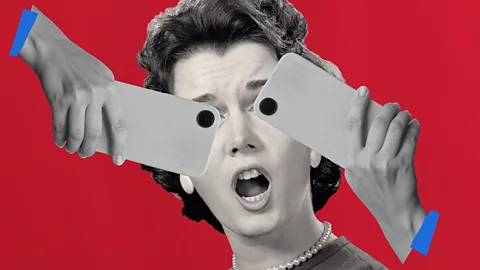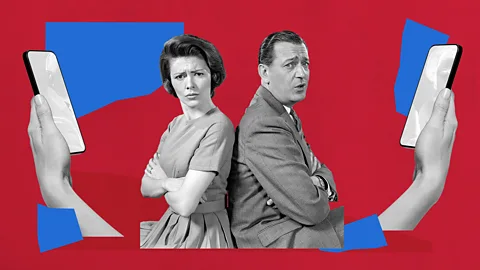How online photos and videos alter the way you think
 Javier Hirschfeld/ Getty Images
Javier Hirschfeld/ Getty ImagesThe images we are exposed to on social media and internet websites have a surprising influence on the way we view the world.
Every day we are bombarded with digital images. They appear on our social media feeds, in our search results and the websites we browse. People send them to us via messaging apps or over email. By the end of today, billions more will have been uploaded and shared online.
With the average user spending 6 hours and 40 minutes per day on the internet, according to one report, these images make up a significant portion of our everyday visual input.
And, recent research indicates that they may even be influencing our perceptions.
One study published earlier this year analysed images on Google,Wikipedia and the Internet Movie Database (IMBD), specifically looking at what genders predominated when they searched for different occupations – such as "farmer", "chief executive officer" or "TV reporter". The findings were stark. Although women were underrepresented overall, gender stereotypes were strong. Categories like "plumber", "developer", "investment banker" and "heart surgeon" were far more likely to be male. "Housekeeper", "nurse practitioner", "cheerleader" and "ballet dancer" tended to be female.
So far, so unsurprising. Anecdotally, I found the same phenomenon myself in 2019, when I was trying to find gender-balanced images for this website. Searching on Getty Creative, one of our main stock photo sites, I had found that photographs of male doctors outstripped female doctors by three to one – even though in the US, for example, physicians under 44 at the time were more likely to be female than male. This depiction of medical professionals were only part of the problem. There were twice as many options for photos of women with babies, or for that matter, of women with salads, as of men.
The latest study, however, took this a step further. Rather than just showing the extent of gender bias in online imagery, the researchers tested whether exposure to these images had any impact on people's own biases. In the experiment, 423 US participants used Google to search for different occupations. Two groups searched by text, using either Google or Google News; another group used Google Images, instead. (A control group also used Google, but to search for categories unrelated to occupations, like "apple" and "guitar"). Then all participants were given an "implicit association test", which measures implicit biases.
Compared to Googling text-based descriptions of occupations, the participants who used Google Images and received visual representations in response showed much higher rates of implicit gender bias after the experiment – both immediately after and three days later.
How not to be manipulated
In today's onslaught of overwhelming information (and misinformation), it can be difficult to know who to trust. In this column, Amanda Ruggeri explores smart, thoughtful ways to navigate the noise. Drawing on insights from psychology, social science and media literacy, it offers practical advice, new ideas and evidence-based solutions for how to be a wiser, more discerning critical thinker.
"The rise of images in popular internet culture may come at a critical social cost," the researchers write. "Our findings are especially alarming given that image-based social media platforms such as Instagram, Snapchat and TikTok are surging in popularity, accelerating the mass production and circulation of images. In parallel, popular search engines such as Google are increasingly incorporating images into their core functionality, for example, by including images as a default part of text-based searches."
There's another growing problem, too: how the images already circulating online are informing and shaping AI models. Earlier this year, I experimented with this myself. I asked ChatGPT to create images for me of dozens of various professionals: doctor, lawyer, scientist, comedian, poet, teacher, customer service representative, nutritionist, thought leader, CEO, expert. Except for two or three results – dental hygienist, nurse and housekeeper – it delivered, again and again, a man. And not just a man, but a slim white man around his 30s with a crop of flowing brown hair.
In a later attempt, trying to get away from career bias, I asked ChatGPT to come up with different sorts of people for me: someone "smart", someone "successful", someone watching an opera, someone watching the show Love Is Blind, someone who quit their job to take care of the kids. Once again, over and over, I got the white guy with the lustrous hair.
 Javier Hirschfeld/ Getty Images
Javier Hirschfeld/ Getty ImagesObviously, models like ChatGPT are learning based on the imagery that already exists. But, once again, this may perpetuate a vicious cycle: the more biased images AI models themselves spit out, the more we see; the more we see, the more implicitly biased we become ourselves. And the more biased we become, the more we create and upload our own biased imagery. (Find out more about how gender biases shape our brains.)
So what can be done? A good deal of responsibility lies with the tech and AI companies. But even when their intentions are good, there doesn't seem to be an easy fix. In its attempt to correct for racial, gender and other biases, for example, Google's AI tool Gemini sometimes overcorrected – one image it generated of the US Founding Fathers included a black man, for example, while an image of German soldiers from World War Two featured a black man and an Asian woman.
In the meantime, we need to take control of shaping our digital visual world ourselves.
While it seems obvious, the fact that we can – to a certain extent – curate our social media feeds often goes overlooked. Seeking out accounts and influencers who are of different ethnic and racial backgrounds, or photographers from different parts of the world, is one easy, actionable tip. We can also influence the search results we get by altering the way we phrase the initial query.
The most effective strategy of all might be reclaiming our time. In the eponymous "digital detox plan" of art entrepreneur Marine Tanguy's book The Visual Detox: How to Consume Media Without Letting It Consume You, for example, there are no surprises, but some good, solid reminders – such as putting limits on when you look at a screen or your phone, deleting apps you aren't using, and spending time outside without technology.
 Javier Hirschfeld/ Getty Images
Javier Hirschfeld/ Getty ImagesI became aware recently that even my several-year-old phone has a timer you can switch on for various apps, choosing whatever time period per day you'd like. While I can't say that I've always heeded its warning when I hit my limit, it's helped me become much more aware of, and cut down on, my social media usage. As we have covered before, putting your phone in another room entirely seems to keep even the thought of checking it at bay.
Above all else, however, it may be awareness that is key. We don't often think about our visual consumption or consider how often we're surrounded by images that have been deliberately created and served to us, often to persuade us to purchase something.
Nor do we think about just how strange and new a phenomenon that is. For the vast majority of human evolutionary history – some 99% of the time we have been around – we wouldn't have seen many images within our own natural environment at all, save some cave paintings or handmade sculptures. While, in Europe, the Renaissance ushered in a new era of image production – which saw the rise of art markets and of artworks made for popular consumption, like printmaking – people still wouldn't have seen anywhere near the number of man-made images that we see today.
In the more than 100,000 generations since the Homo branch of the evolutionary tree emerged, we have evolved to spend far more time looking at the world (and people) around us than at images, never mind images on a screen. Perhaps, it seems, there is an argument for trying to incorporate more of that time away from our screens into our everyday lives today.
*Amanda Ruggeri is an award-winning science and features journalist. She posts about expertise, media literacy and more on Instagram at @mandyruggeri.
--
If you liked this story, sign up for The Essential List newsletter – a handpicked selection of features, videos and can't-miss news, delivered to your inbox twice a week.
